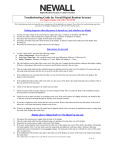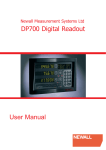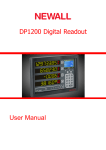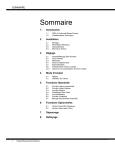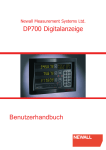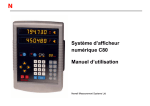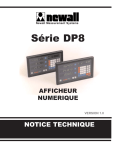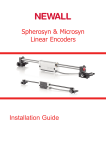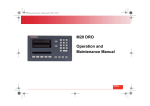Download User Manual DP500 Digital Readout
Transcript
DP500 Digital Readout User Manual Contents Specification Electrical Physical Environment Accreditation Disposal Input and Resolution Page 3 Page 3 Page 3 Page 3 Page 3 Page 3 Page 3 Mounting Options Mill Mount Lathe Mount Page 4 Page 4 Page 4 Connection Details Important Information Connections Page 5 Page 5 Page 5 Display and Keypad Understanding the Display Understanding the Keypad Page 6 Page 6 Page 6 Setting up the Unit Navigating Complete Setup Navigating Complete Setup (Continued) Language Setup Type Setup Encoder Type Setup Encoder Resolution Setup Direction of Travel Setup Radius / Diameter (Measure Setup) Error Compensation Linear Error Compensation Linear Error Compensation Setup Segmented Error Compensation Setup Using Segmented Error Compensation Plane Setup Functions Setup Beep Setup Sleep Setup Reset Setup Page 7 Page 7 Page 8 Page 9 Page 9 Page 9 Page 9 Page 10 Page 10 Page 11 Page 12 Page 13 Page 14/15 Page 15 Page 15 Page 16 Page 16 Page 16 Page 17 Standard Functions Absolute / Incremental Inch / mm Zero and Preset an Axis Undo Function 1/2 Function / Centre Find Reference Page 18 Page 18 Page 18 Page 19 Page 19 Page 20 Page 20 Mill Functions Pitch Circle Diameter (PCD) / Bolt Hole Page 21 Page 21 Lathe Functions Tool Offsets Multiple Tool Datums Page 22 Page 22/23 Page 24 Trouble Shooting Page 25 2 Specification Electrical EU Directive 73/23/EEC (Low Voltage Directive) BS EN 55022:1998 Class B BS EN 55024:1998 Input to Power Supply Unit (Supplied) 100-240V (47-63Hz) External switch-mode - Output voltage 15VDC Input Voltage to DP500 15-24VDC ±10% Conforms to Low Voltage Directive Physical Height Width 170mm (6.69") 260mm (10.23") Depth Weight 48mm (1.89") 1.5kg (3.3lb) Mounting Bolt: M10 Environmental Climatic Range Storage Temperature Working Temperature Working Humidity IP-Ingress Protection IP40 Stand Alone -20°C to 70°C -10°C to 50°C 95% R.H. at 31°C Accreditation CE Disposal At the end of its life, you should dispose of the DP500 system in a safe manner applicable to electrical goods Do not burn The casework is suitable for recycling. Please consult local regulations on disposal of electrical equipment Input & Resolutions Only Spherosyn LT or Microsyn LT encoders can be used with the DP500 DRO Resolutions Spherosyn LT or Microsyn LT (10µm) 5µm (0.0002") 10µm (0.0005") 20µm (0.001") 50µm (0.002") Newall Measurement Systems Limited reserves the right to make changes to this specification without notice 3 Mounting Options This chapter details the various mounting options for the DP500, both the standard version and the panel mount version. Mill Mount (Non Adjustable) Lathe Mount (Non Adjustable) 4 Connection Details This chapter details the cable connections for the DP500. Important Details You can only use the DP500 with Newall Spherosyn LT and Microsyn LT analogue encoders. You need to ensure that: You secure all the cables to prevent the connectors from dropping into hazardous positions (for example the floor or coolant tray) when you unplug them. You route all cables to prevent them from being caught on moving parts. The DP500 is grounded to the machine, using the braided grounding lead provided, before you turn on the machine supply. The power has been disconnected, before you connect the encoder(s). Do not connect this unit directly to the mains supply. If an encoder connected to the DP500 travels over 2.2m an error code (2.1) will be displayed in the X axis and the other axes will go blank. See the trouble shooting guide for further details on page 25. Connections Encoder input connection 2 or 3 according to model Cable clamp External PSU input 5 Cabinet equipotential terminal for grounding to machine Display and Keypad This chapter explains how to interpret the display and use the keypad. Understanding The Display Axis 1 950.355 Axis 2 100.250 Axis 3 156.255 T0 0 l 01 Message Display Power LED Understanding The Keypad Axis Selection Key Digifind / Reference Switches between Zero and Axis Preset modes Numeric Keys Switches between Absolute and Incremental modes Enter Key Switches between Inch and mm display Clear Numeric Entry Centre Find Information selection (scrolls through options on Message display) Undo Key Function Menu Key Sleep Key Function Navigation Keys 6 Setting Up The Unit Navigating Complete Setup How to enter setup Until display shows setup Language Eng gb Note: Other languages may be available setup type setup Encoder nn26-lt cesky espanol nederlan russian Microsyn LT (10µm) Spherosyn LT ---i 7 setup code? afr. deutsch italiano portugue S26-lt setup dir setup plane Eng us dansk francais pol turkce nnill lathe 0.005 setup err comp Unit then displays generic setup res setup measure funcs Setup 0.01 0.02 0.05 I--- rad dia select none linear segments (----) (----) (----) (----) (----) (----) Only applicable to 3 axes units Setting Up The Unit Navigating Complete Setup (continued) setup funcs set func tools on off set func PCD on off setup beep on off setup sleep 0 user defined, use numeric keypad to enter value (value is in whole minutes) (Default is inactive) setup reset reset as To exit setup generic nnill lathe 8 Setting Up The Unit Language Setup This setting enables the user to choose the language that is required to be displayed in the DP500 display. There are 14 language settings: Eng gb English UK (Default) Eng us francais deutsch italiano dansk portugue espanol turkce English US French German Italian Press the axis select key Danish Portuguese Spanish Turkish next to the ‘X’ axis to cycle through options russian cesky afr. nederlan pol Russian Czech Afrikaans Hollandic Polish Note: Other languages may be available Type Setup This setting enables the user to choose the machine type that the DP500 operates in. There are 3 settings: Generic nnill lathe Press the axis select key next to the ‘X’ axis to cycle through options Note: When set to lathe the x axis changes to diameter measurement Note: When set to lathe or mill some functions are automatically turned off Encoder Type Setup The encoder settings must match the actual encoder in use, or the DP500 will not measure correctly. Newall encoders that work with DP500: Spherosyn LT Microsyn LT (10µm) Press the axis select key s26-LT Nnm26-LT next to the ‘X’, ‘Y’ or ‘Z’ axis to cycle through options Encoder Resolution Setup The resolution settings available for each axis depend on the inch/mm setting. µm 5 10 20 50 Display mm in 0.005 0.0002 0.01 0.0005 0.02 0.001 0.05 0.002 Press the axis select key 9 Spherosyn™ LT Microsyn™ LT (10µm) next to the ‘X’, ‘Y’ or ‘Z’ axis to cycle through options Setting Up The Unit Direction of Travel Setup You use the direction setting to match the DP500 to the actual direction of travel of any axis. There are two settings for each axis Press the axis select key ---i and i--- next to the ‘X’, ‘Y’ or ‘Z’ axis to cycle through options Example ---i If the current setting is the setting to i--- and the travel is positive from right to left, changing will reverse the direction to measure positive from left to right. Radius / Diameter (measure Setup) The radius/diameter function allows the operator to display actual (radius) or twice-actual (diameter) measurements for each axis. This function is generally used in turning applications, such as the cross travel on a lathe where you want to display the diameter reading rather than the radius. There are two settings for each axis: Radius rad Diameter dia Press the axis select key next to the ‘X’, ‘Y’ or ‘Z’ axis to cycle through options 10 Setting Up The Unit Error Compensation Your digital readout (DRO) system helps you to improve productivity. It decreases the number of scrapped parts, as you no longer have to be concerned about making mistakes related to counting the revolutions on the dials. Your DRO system also helps to eliminate some errors related to ballscrew backlash. Your DRO system will operate to its published accuracy, provided all components are in working order and properly installed. Field calibration is not necessary. Accuracy problems with machined parts may be caused by machine error, DRO system error, or a combination of both. The first step in determining the source of error is to check the DRO system. You do this by comparing the movement of the Newall reader head to the position reading shown on the display. You need a high accuracy standard, such as a laser interferometer. You can use a dial indicator to check short distances, but a laser provides the best results. If you have to use a dial indicator, be sure it is the highest available accuracy. To check the accuracy of the DRO system: 1. Place the target of the laser or the needle of the dial indicator directly on the Newall reader head. It is absolutely critical that you take the readings directly from the Newall reader head. If you have to use a dial indicator, be sure that the needle of the indicator is perpendicular to the reader head and not angled. If you take readings anywhere else on the machine, machine errors may distort the results. 2. When the reader head moves, the movement registers on the laser / indicator and DRO display. 3. Set the laser / dial indicator and DRO position displays to 0. 4. Make a series of movements and compare the position readings between the laser / dial indicator and the DRO display. If the readings match within the accuracy specified, then you know that the DRO system is operating properly. If this is the case, you can proceed to the next step: evaluating the machine errors. If the readings do not match, you must repair the DRO system before proceeding with error compensation. To evaluate machine errors: 1. Put the laser target / dial indicator on the part of the machine where the machining is done. 2. Make a series of movements and compare the position readings between the laser / dial indicator and the DRO display. The difference between the laser / dial indicator reading and the reading on the DRO display is your machine error. 3. Plot the machine error along the entire axis of travel to determine the nature of the error. If it is a linear error, you can use linear error compensation. If the error is not linear, you should use segmented error compensation. 11 Setting Up The Unit Types of Machine Error There are many types of machine error, including pitch, roll, yaw, flatness, straightness, and Abbé error. The diagrams below demonstrate these errors. Abbé error Way errors Yaw Axis Typical Yaw Deviation C2 C1 C1 Straightness C2 B B1 Roll Axis Encoder A A1 End Effector Travel Pitch Axis B1 B2 greater than Linear encoder less than encoder A2 Encoder A1 End Effector Linear encoder Flatness Typical Pitch Deviation Shown with encoder on concave side of bearing path Shown with encoder on convex side of bearing path Linear Error Compensation In this mode, you can apply a single constant correction factor for each axis to all displayed measurements. You calculate the correction factor, and specify it in parts per million (ppm). In this mode a single constant correction factor for each axis is applied to all displayed measurements. Error Travel As you follow the procedure you must ensure that you either use a stepped standard, and approach each edge from the same direction; or if you must approach each edge from opposite directions, then subtract the width of the tool or measuring probe from the value displayed on the DP500. Tool or Probe Tool or Probe measured distance = standard distance standard distance (Fig 1) measured distance 12 Setting Up The Unit Linear Error Compensation Setup This setting allows you to setup compensation factors for linear errors. There are two methods of entering compensation values Teach mode and Program mode. Teach Mode Teach mode is an easier way of calculating linear errors by using the DP500 to automatically calculate the error, by comparing the actual measurement and the physical movement. The procedure to do this is shown below. Error comp select screen is displayed Press the axis select key next to the ‘X’, ‘Y’ or ‘Z’ axis which requires linear compensation Press the key to Navigate to Linear. Press Press the key to Navigate to Teach. Press Display Shows ax1 tch at zero? ax1 tch at End? Move tool / probe to start position (see fig 1) Press Move tool / probe to end position (see fig 1) Press Display Shows ax1 tch movemnt? Enter the actual measurement using numerical keypad Press Display Shows ax1 tch accept? Press Display Shows to accept, or to decline If accepted, goes back to error comp select screen Program Mode First you must determine the correction factor required.To do this you use the following equation. (In the following example the standard distance is 500.000mm and the measured distance is 500.200mm). Values can be entered in Inches or millimetres. Correction factor = error / actual x 1,000,000 Correction factor = (500 - 500.200) / 500.000 x 1,000,000 Correction factor = -400 Error comp select screen is displayed Press the axis select key next to the ‘X’, ‘Y’ or ‘Z’ axis which requires linear compensation Press the key to Navigate to Linear. Press the key to Navigate to Program. Press Display Shows Press ax1 prog ppm Enter -400 from the example above using the numeric keypad Goes back to error comp select screen 13 Press Setting Up The Unit Segmented Error Compensation The scale travel is broken down into as many as 200 user-defined segments, each with their own correction factor, measured against a laser interferometer. The following parameters need to be identified: Starting point - zero 5 1 Error 4 2 6 0 Travel 3 Correction points Reference point Each Correction Point is measured with respect to the Starting Point - zero - which should be set at the negative end of travel, the DRO must be counting positive when moving away from the starting point. The Reference Point can be set anywhere along the scale, and does not need to coincide with either the absolute datum or any of the correction points. However, it may be convenient to make the absolute datum and the reference point the same. Always approach the Starting Point, Correction Points and Reference Point from the same direction. If you do not, then the size of the tool or probe will render the measurement inaccurate. Digifind should not be used if segmented compensation is active, datums set in normal DRO mode will not affect segmented error compensation. Segmented Error Compensation Setup Procedure for setting segmented error compensation Error comp select screen is displayed Press the axis select key select next to the ‘X’, ‘Y’ or ‘Z’ axis which requires segmented compensation Press the key to Navigate to segments. Press Press the key to Navigate to Teach or Program Press Teach Mode: Enter new segments Teach Mode Display Shows Display Shows Display Shows ax1 tch set ref ax1 tch set zero ax1 tch goto 1 setup err comp Program Mode: Edit previously entered segments Move machine to reference point Press Move to zero Press Move to first position Press Display Shows ax1 tch movemnt? Display Shows ax1 tch accept? The difference between the DRO and laser will Press be displayed Display Shows ax1 tch contnue? Press Enter the actual movement* using numerical keypad Press to move to next point, or to accept, or to decline to finish Goes back to error comp select screen * Actual movement = total accumulated movement of all segments completed, as shown on laser interferometer 14 Setting Up The Unit Program Mode Display Shows ax* edit seg 001 The existing compensation value(s) for each segment are displayed in each axis. The displayed value is the difference between the laser interferometer and the DRO registered movement over the segment length. To Edit: Enter number using numerical keypad, press Press To navigate to other segments use Press to accept , or enter segment number and then press to finish Using Segmented Error Compensation Note. When using Segmented error, each time you turn on the DP500 you need to move to the machine reference point. The DP500 will prompt you for this on power up, see below. reset segments reset? Note. Reset will only appear on an axis if segmented error has been implemented reset reset Move each axis to the reference point and then press next to the axis in question Once all axes have been reset to reference the DP500 will go into normal operating mode Plane Setup This setting enables the user to choose the plane in which certain functions will operate. The plane consists of two axes that require to be set for certain functions to operate correctly. There are three possible settings: (----) setup plane (----) Press To scroll through options (----) (----) (----) (----) Note: Only applicable to a 3 axes unit 15 (----) (----) Setting Up The Unit Functions Setup This setting enables the user to choose the functions that are required to be used with the DP500. Functions that are switched off will not show in the function menu or message display. Function On on off Function Off Press the axis select key Press the next to the ‘X’ axis to cycle through options key to Navigate through functions the list of functions can be found below set func tools Tool Offsets set func pcd Pitch Circle Diameter / Bolt Hole Circle press to exit Beep Setup This setting enables the user to have the option of an audible tone on pressing any of the keys on the DP500. There are two settings: Key Beep on on Key Beep off off Press the axis select key next to the ‘X’ axis to cycle through options Sleep Setup This setting enables the user to define an automatic sleep mode after a period of time. The user either leaves the default setting at 0 which deactivates the sleep mode, or inputs a value (in whole minutes) for when the sleep mode is initiated after no operation of the DP500. To exit sleep mode, simply move an axis or press any key. There are two settings: Sleep Mode deactivated Sleep Mode Active 0 (Default) 15 Enter the required value via the numeric keypad, Press to accept the value. Note: The number in the display is the value in whole minutes before the DP500 will enter sleep mode. The key can be used to manually enter/exit sleep 16 Setting Up The Unit Reset Setup This setting enables the user to reset the DP500 unit back to factory defaults. There are three factory default settings: Default as Lathe / Mill generic Default as Mill nnill lathe Default as Lathe Press the axis select key Press to accept the option. no Press the axis select key Press next to the ‘X’ axis to cycle through options reset sure? next to the ‘X’ axis to cycle between yes and no. to accept. Please note: When the DP500 is defaulted as a lathe the X axis default setting is DIA and therefore the X axis will measure double. OEM Defaults: The DP500 may have OEM default settings specific to a machine. In this case the DP500 will only display one reset option. This reset will default all parameters to match the machine it has been provided with. 17 Standard Functions This chapter details the standard functions of the DP500. Absolute / Incremental Press to toggle between absolute and incremental mode Absolute (abs) mode has been selected The DP500 has a dedicated key to switch the positional displays between absolute (abs) and incremental (inc) measurements. The current display mode is indicated by a red LED either above or below the key as shown right. Incremental (inc) mode has been selected Using Incremental Mode In Incremental mode the DRO displays the position relative to the last position. This is also known as point-to-point use. In this mode you can set the value for each axis, or zero it to create an Incremental datum. This does not effect the machine’s Absolute datum that you configure in Absolute mode. 70 30 40 50 Using Absolute Mode In Absolute mode the DRO displays the positions of all the axes with respect to a fixed datum. The datum is set by entering an axis position when in Absolute mode. 30 100 140 190 Example of Absolute and Incremental use Move to first position in ABS (Hole A) Switch to incremental mode and zero the display 150.000 100.000 0.000 0.000 Y C 50 Move to second position in ABS (Hole B) 300 B A (0,0) Make an incremental move to Hole C 0.000 50.000 Switch to absolute mode 100 30.000 30.000 200 0.000 0.000 30 Set absolute zero at lower left corner of the part X 30 150 150.000 150.000 Inch and mm Press to toggle between Inch and mm mode The DP500 has a dedicated key to switch the positional displays between imperial (inch) and metric (mm) measurements. The current display mode is indicated by a red LED either above or below the key as shown right. Imperial (Inch) mode has been selected Metric (mm) mode has been selected 18 Standard Functions Zero and Preset an axis Press to toggle between ‘set’ and ‘zero’ mode The DP500 has a dedicated key to switch the operation of the axis selection key between zero mode and set mode. The currently selected mode is indicated by an LED either above or below the key as shown right. Zero mode has been selected Set mode has been selected Using Set Mode With set mode selected, this enables the select axis keys to prompt a numeric entry into the desired axis. Once the correct value has been selected, it can be set into the axis by pressing the enter key. This can be seen in the example on the right. 0.000 Press the axis select key relevant to the axis 0 Input the required numeric value -145.230 Zeroing an Axis in Set Mode With set mode selected, it is possible to zero the axis conveniently by double pressing the relevant select axis key. This can make use of the DP500 zeroing and set modes much quicker and easier. This is shown in the example on the right. -145.230 0.000 Using Zero Mode With zero mode selected, this enables the select axis keys to zero each axis independently. This can be seen in the example on the right. Press the axis select key relevant to the axis 0.000 Undo Function The DP500 stores the last 10 positions/numeric inputs, which can be accessed using the undo feature Example 1 - non movement Display shows -145.230 input a value 95.520 You have inputted an incorrect figure and want to get back to the dimension shown before Press Display now shows -145.230 Example 2 - movement input a value input a value 5.000 10.000 move to that point, display now shows move to that point, display now shows 0.000 0.000 Press once, display now shows -10.000 this is the position of your second point Press again, display now shows -15.000 this is the position of your starting point 19 Standard Functions Half Function / Centre Find Press to initiate the half function. The DP500 has a dedicated key to half the value in any axis. This is done by initiating the half mode and selecting the required axis. This can be seen in the example on the right. 100.000 Press the axis select key relevant to the axis 50.000 Digifind / Reference Function The DP500 comes equipped with Digifind, a feature unique to Newall digital readout products. Digifind eliminates the risk of losing your position and datum Set-Up.With Digifind, precise SetUp of a workpiece is carried out only one time. When the DP500 is powered on, it displays the position at power off, compensated for any movement of a Spherosyn LT transducer up to 0.2500" (6mm) and a Microsyn LT encoder up to 0.1000" (2.5mm) in either direction since the unit was last used. If the machine has moved beyond 0.2500" (6mm) Spherosyn LT [0.1000" (2.5mm) - Microsyn LT], Digifind allows a quick means to find the datum if lost. A mark must be made on both a stationary part and moving part of the machine.The marks must be aligned and will serve as the machine "home" position. The mark must be indelible, and it must allow the operator to move the machine to within a 0.2500" (6 mm) - Spherosyn LT [0.1000" (2.5mm) - Microsyn LT ] band around the mark at any time. Alternatively, you can use a convenient reference point on the workpiece Setting the reference Until message display shows , Message display shows set ref sel axis digifind set ref of axis required The reference point is now set Finding the reference If datum is lost at anytime it is possible to “Find” the datum again. Position the machine to within the 6mm (0.2500”) band for Spherosyn LT and 2.5mm (0.1000”) band for Microsyn LT. “Find” the reference. Until message display shows , Message display shows find ref sel axis digifind find ref of axis required The position to the absolute zero for that axis is now displayed Finding zero As a fail safe, Digifind can ‘find’ the last datum or absolute zero set. Position the machine to within the 6mm (0.2500”) band for Spherosyn LT and 2.5mm (0.1000”) band for Microsyn LT. “Find” the reference. , Until message display shows Message display shows find 0 sel axis digifind find 0 of axis required The original datum is reset Note: Display must be in ABS mode for digifind actions 20 Mill Functions This chapter details the Mill functions of the DP500. The mill functions use the plane setting from setup. PCD / Bolt Hole Circle The DP500 calculates positions for a series of equally spaced holes around the circumference of a circle. The message display prompts the user for various parameters it needs to do the calculations. Once the DP500 completes the calculations, the axis displays show the distance to each hole. The operator works to Zero for each hole location. See example below. How to navigate to PCD function. funcs pcd Until message display shows , Example Message display shows 125.250 99.700 PCd centre Enter centre co-ordinates (See using set mode P19) PCd diameter Enter the diameter value (See using set mode P19) 150.000 PCd holes Enter the number of holes (See using set mode P19) 5 PCd angle Enter the start angle value (See using set mode P19) 18 Note: The PCD will be calculated from the 3 0‘clock position, anti-clockwise. Enter the angle as a negative value if it is given as clockwise from 3 o’clock. Note: At this point you can use the menus. keys to navigate back and forth through the above Y axis PCd go -196.580 -122.880 (-196.580, -122.880) Starting hole 18º starting angle PCd go hole 01 Note: The numbers appear as negative values because the operator works to zero. Circle centre 150mm diameter 99.7mm Datum 125.25mm Navigate through the sequence of holes by using The maximum number of holes is 999 21 X axis keys, or enter hole number then press Lathe Functions This chapter details the Lathe functions of the DP500. Tool Offsets The Tool Offset function allows the operator to enter and store offsets for a range of tools.This enables the operator to change tools without resetting absolute zero or datum. Using tool offsets ensures that diameter and length measurements will remain consistent after tool changes.This speeds up tool changes and increases productivity as it eliminates the need for the operator to stop and manually measure the diameter. The number of Tool Offsets available is 50. This large number allows tools to be grouped where more than one set is used. For convenience, it is highly recommended that tools are physically marked with their corresponding tool number. There are two ways to set tool offsets, teach mode and program mode. How to navigate to the tool offset function. , Until message display shows funcs set tool Teach Mode Display will show tools teach Display will now show select select teach tool 01 Select the Note: axis needed teach capture In this example the X axis has been selected to select different tools Display will show 0.000 Take a skim cut if X axis is selected, or take a face cut if Z axis is selected Display will show 0.000 teach value Note: at this point you can move the tool away from the part Measure the part with an accurate gauge and enter this value using the numeric keypad. Repeat the above process for all the tools required. to exit tool set mode 22 Lathe Functions Program Mode Display will show tools program tools teach Display will now show 0.000 0.000 set tool tool 01 Note: keys, or enter hole number then press Take a skim cut if X axis is selected, or take a face cut if Z axis is selected Note: Tool must not be moved off the part after taking the cut. User needs to enter the difference between measured diameter and readout value Repeat the above process for all the tools required. to exit tool set mode Using Tool Offsets Until message display shows feed 00 tool 01 The message window displays which tool is in use feed 00 tool 01 To scroll through different tools, or enter tool number on numerical keypad at any time. 23 to select different tools Lathe Functions Multiple Tool Datums The Multiple Tool Datum function offers several advantages when compared to the standard Tool Offset function. - Multiple Datums - Each tool has its own independent datum (tool datum) - Quick Tool Edits - Changes can be made on the fly, with live position display Application Several tools are required for work on a particular piece. For example there might be a roughing tool, a finishing tool, a thread cutting tool, ID boring tool, etc. A separate datum can be set for each tool. Changing one tool does not affect the other tools. Using Multiple Tool Datums Until message display shows feed 00 tool 01 Until set mode is selected to change tools. Current tool # is displayed in the message window Setting Tool Datum of axis required to select datum recall wil be displayed tool datm Enter desired numerical position value recall Repeat as necessary for other tools 24 Trouble Shooting Guide Symptom The display is blank Solution • • • • • The DP500 maybe in sleep mode. press any key to exit sleep mode Check that the power supply is correctly connected to a working mains outlet Check that the power supply cables are not damaged Check that the power supply voltage is 15 - 24Vdc ±10% Check the power supply indicator is illuminated on the front of the DP500. Either the supply voltage is too low, or the power supply or mains supply has an intermittent fault. The display works, but resets from time to time with• Check that the power supply voltage is 15 - 24Vdc ±10%. out any keys being pressed. • Check that all the connections are secure. The display works, but gives erratic readings, the last digit jitters or the measurements jump to new figures unexpectedly. The unit does not respond to any key presses. There may be a poor earth (ground) connection. Both the DP500, and the machine on which it is installed, must have proper earth (ground) connections. There may be a problem with the encoder. Disconnect the DP500 from its power supply, wait 15 seconds and then reconnect. This indicates that the unit is not receiving a proper signal from the encoder. ‘NO Sig’ / ‘SIG FAIL’ or ‘1.x’ appears in the display. Readings are incorrect. • Check that the encoder connections are secure. • Check that there is no damage to the connectors or to the encoder. • Switch the DP500 off and back on again. • Swap the encoder to another axis to confirm whether the encoder or the DP500 is at fault. • Check the Encoder Type to ensure it is correct. • Check the Radius / Diameter setting. The Diameter setting causes the axis to read double. • Check the Error Compensation factors. • If using the Segmented Error Compensation, verify the datum position. • Swap the encoder to another axis to confirm whether the encoder or the DP500 is at fault. • Check that there is no damage to the encoder or its cable. • Check that the encoder is fixed firmly and aligned correctly, as described in the Spherosyn / Microsyn Installation manual. • Check that there is no binding on the scale. With the scale brackets slightly loosened, you t should be able to slide the scale back and forth with minimal resistance. • If you have a Spherosyn LT scale, check that the scale is not bent, by removing it and rolling it on a flat surface. This indicates that the encoder has travelled further than the maximum allowed travel 2.1 appears in the display. • This type of error can only be cleared by cycling the power to the DP500. • The sleep button to reset the DP500 will not clear this type of error. If the solutions suggested above do not solve your problem, contact Newall for further instruction. To swap encoders to trace a fault: 1. Check that the two axes are set to the correct encoder types. 2. Disconnect the DP500 power supply. 3. Disconnect the encoder from the malfunctioning axis and move to a working axis. 4. Reconnect the DP500 power supply and turn on. If the fault stays with the same encoder, then the encoder is at fault. If the fault does not follow with the encoder the DP500 is at fault. Providing you have not moved the machine more than 6.3mm (0.25”) for a Spherosyn LT Encoder or 2.5mm (0.1”) for a Microsyn LT Encoder, switching the power off and back on again does not lose the datum position. 25 Newall Measurement Systems Ltd. Technology Gateway, Cornwall Road South Wigston, Leicester LE18 4XH United Kingdom Tel: +44 (0) 116 264 2730 • Fax: +44 (0) 116 264 2731 E-mail: [email protected] • Web: www.newall.co.uk Newall Electronics Inc. 1803 O’Brien Road Columbus, Ohio 43228 USA Tel: +1 614 771 0213 • Fax: +1 614 771 0219 E-mail: [email protected] • Web: www.newall.com Custom Sensors & Technologies 11F Chang Feng International Tower 89 East Yunling Road Shanghai, 200062 China Tel: +86 21 8025 7166 • Fax: +86 21 6107 1771 E-mail: [email protected] • Web: www.newall.cn 023-82130-UK/0




























